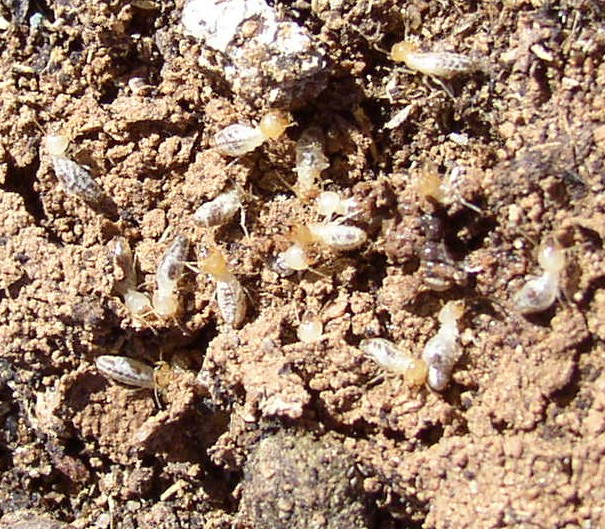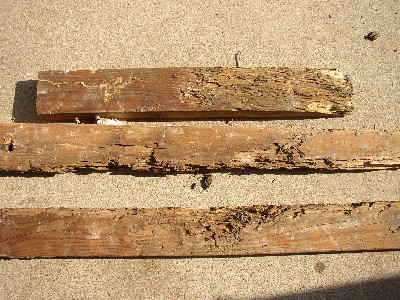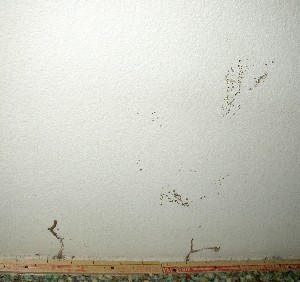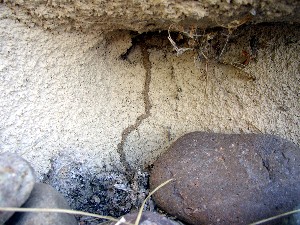
Description:
There are three termite families: Dampwood, Drywood and Subterranean. The most common in the Phoenix area is the Subterranean termite. The termite operates in a caste system where the workers, soldiers and reproductives are interdependent to make a successful colony. The workers are most numerous in the colony and aptly do all the “work”; “work” translates to damage. They feed their caste mates, keep the nest clean, build the mud tunnels and attend to the queen. They are uniformly light colored (almost white). They need no pigment because they live in the dark underground colony or travel in mud tunnels they’ve constructed above ground. The soldiers bodies are slightly larger than the workers but their heads are much larger. They have pronounced mandibles and their head is a darker color. They protect the colony from invaders such as ants. Reproductives make up the remainder of the colony. Termites are easily differentiated from ants in that termites have a thick waist, not pinched; straight antennae, not elbowed; and when the reproductives have wings, both pair are of equal length. Ants top wings are longer than the wings underneath.

Termites require specific environmental conditions to survive. Moisture is critical since they are very soft bodied and lose moisture through their skin rapidly. When searching for food above ground, they construct mud tubes or tunnels to travel through.
These tubes hide them, provide a moist environment and protect them from their enemies. Moisture and warm conditions inside their nests also provide a place for fungi to grow which is an important source of protein and vitamins the termites need. Too much moisture is not good as the fungi grows faster than the termites can ingest. Unseen moisture problems like leaky plumbing inside walls or irrigation spraying on exterior walls ( water “wicks” into the wall studs) are some conditions that increase the likelihood of fungi. Fungi for termites is like sugar for ants. This attraction increases the likelihood of infestation and damage as they are likely to eat more of the wood member.
Normally, subterranean termites will primarily feed on the rings containing the soft spring wood and leave the rings of hard winter wood behind. With excessive moisture the whole wood member is soft therefore more palatable. Damaged wood with the presence of mud or soil is usually indicative of a termite infestation. Another sign of termite infestation is the presence of pin holes, small pinhead size holes running the same direction as the wood studs in the walls or ceilings.
These are exploratory holes where the termites are looking for a wood source on the other side of the wall.
If no food source is detected they patch up the hole and move on. These holes may be spaced several feet apart, so often times, to the inexperienced eye, they go undetected. Somewhere following the line of these holes termites usually, but not always, create an actual tube made from wood, drywall dust and mud. This same concoction is what they use to patch their pin holes.

Termites fall into 4 primary categories. The workers do all the work and live the shortest life approximately 1 year. Soldiers are for the colony’s protection and also live in the one year range. The Reproductives (current and future kings and queens) live the longest. When they head their own colony they may live 10 years or more. As termite colonies grow they have more reproductives than needed. To reduce the existing population and to start a new colony they use a process called “swarming”. The backup reproductives wait for the right conditions to swarm. Swarming occurs when the weather is warm, humid, usually after a rain (monsoons) and possibly a little overcast. These conditions make the best opportunity for the newbies to be successful. Unfortunately for the termite, less than 3% of the backups survive to start a new colony. With a quick molt they grow wings, gain a pigment for protection against the light (auburn brown for sub termites) come to the surface of the soil or exit an existing mud tube and fly into the sky. The female sends out a pheromone (chemical attractant) to invite a mate, they pair up, drop to the ground, and discard their unneeded wings. Queens generally mate once (sorry guys) and start laying eggs to produce workers. Reproductives and soldiers do not forage for their own food. They are fed via regurgitation by the workers. New queens and kings won’t eat until their first brood of workers are capable of feeding them. Some entomologists believe the reproductives survive on the absorption of protein from the wing muscles they no longer have. The presence of cast off termite wings around your home is commonplace in the desert several times a year. They are so light they usually blow away but can be found on the ground around outside windows, lights or in the pool or skimmer. This indicates termites are in the area, not immediately infesting your home. If they are in the area however, it does mean good termite protection is needed to prevent them from bumping into your home for supper.

Other things to do to prevent termites around your home: repair leaky spigots, irrigation valves, watering lines and generally keep moisture away from the foundation of your home. This removes a supportive condition and helps the termiticide products applied around your home to be as effective as possible. Remove excessive cellulose debris (Cellulose is the target food element of the wood being eaten) leaf litter and firewood are big no no‘s. If you have a home with a crawl space never store wood under the home. Fence posts or porch pillars should not be in the ground and attached to the home. Support them (not surround) with a concrete footing or separate with metal flashing to eliminate direct access to the wood. On stucco homes the outside ground level must be below the stucco bottom at least 3 inches for visibility as well as termite access. On block homes the level shouldn’t be higher than the inside floor height. If cracks or spaces develop between blocks termites can enter and eat the carpet tack strip, the firring strips (drywall support) and baseboards. Also, make sure any water would drain away from the home not sit against the foundation. These are good starts to prevent the conditions that termites require. Termites will probably find your home eventually so annual inspections by a qualified professional is essential. An initial termite treatment and an annual warranty, annual inspections, as well as re-treatments, when necessary, are provided.
















 Our technicians have up-to-date knowledge of techniques available for use in treating your home and business and will create customized treatment and maintenance programs for each customer!
Our technicians have up-to-date knowledge of techniques available for use in treating your home and business and will create customized treatment and maintenance programs for each customer!